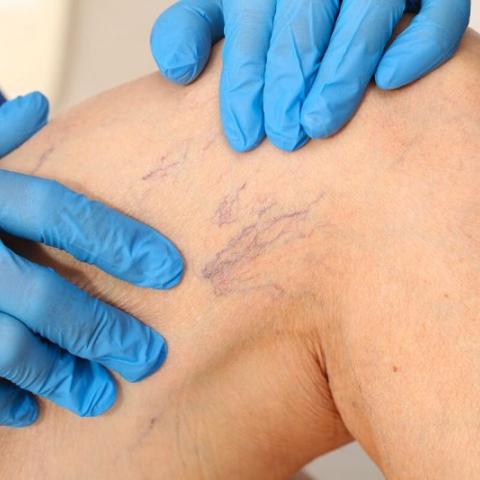Vascular Surgery

WHAT IS VARICOSE?
Overview
It is the appearance of veins under the skin as blue, enlarged and folded. Although swelling is seen as a result of the expansion of the veins at the beginning, with the increase in varicose findings, large vein clusters can be formed and even cracks can be seen in the veins.Although it is mostly uncomfortable in terms of appearance in the first years, it can cause pain in the later process. When venous failure improves, swelling occurs in the legs. If clots occur in varicose veins, thrombophlebitis occurs, which manifests itself with pain, swelling and redness in the legs.If clots occur in varicose veins, thrombophlebitis occurs, which manifests itself with pain, swelling and redness in the legs. If clots occur in varicose veins, thrombophlebitis occurs, which appears as pain, swelling and redness in the legs.
What are the Symptoms of Varicose Veins?
- – Blue-purple swelling in the legs
- – Feeling of heaviness in the legs
- – Numbness in the legs
- – Pain and itching in the legs
Why Does Varicose Occur?
- Many factors play a role in the formation of varicose veins. Obesity, standing for a long time, spesific occupations, pregnancy, long-term use of birth control pills, hormonal treatments, tight clothing, old age, genetic factors and constipation are the main causes.
- Varicose veins occur as a result of the failure of the valves that help the blood in the veins to move against gravity. The blood constantly moves towards gravity and edema occurs in the legs.
- Varicose veins can occur at any level of the veins. Sometimes this enlargement can even be caused by a clogged vessel
What are the Types of Varicose Veins?
- Capillary varicose veins (Telengiectasia)
- Great Vein Varices
- Reticular varices
- Capillary Varicose Veins; They look like spider webs in appearance. They are very common after pregnancy and in women using hormones.
- Reticular varicose veins are composed of slightly raised and blue colored veins from the skin, which are mostly seen behind the knee and around the ankle.
- Great Vein Varices are seen in the insufficiency of the large vein called the saphenous vein and the small vein called the parval vein in the leg. They become greenish and are raised from the skin.
What Kind of Problems Cause Varicose Veins?
At first, they only cause discomfort in appearance, then severe pain in the leg, inflammation in the veins (thrombophlebitis), clot formation in the varicose vein and then pulmonary embolism can be seen with the clot going to the lungs.
Treatment of Varicose Veins
- The most traditional method is to remove the varicose vein. However, the recovery period after surgery is long. Applying foam into the vein is another method. However, the probability of recurrence is high.
- In laser treatment, a catheter is placed into the vein and a beam is sent from the laser device to burn the vascular endothelium.
- The same method can be done using Radiofrequency waves.
- Another method is the peripheral vein embolization technique, which is called an embolizing agent and is a method of injecting the lumen into the vein through a catheter and attaching the lumen.
- All these procedures can only be performed under local anesthesia and patients can be discharged after a day treatment.
Can the growth of varicose be prevented?
- 1- Not working by standing for a long time
- 2- Losing excess weight
- 3- Not sitting cross-legged for a long time
- 4- Not wearing very tight and tight clothes
- 5- If you have been standing for a long time, resting by lying down and raising your legs
- 6- To avoid constipation, to consume high-fiber foods
- 7- Regular exercise (running, walking, cycling, swimming)
- 8- The use of compression stockings by professionals who make it necessary to stand
- 9- Walking occasionally on long journeys
Peripheral Artery Disease
Peripheral arterial disease includes all arterial diseases except the heart and brain. It occurs when the arteries that provide blood flow to the arms, legs and internal organs are completely or partially blocked due to atherosclerosis (hardening of the arteries).Peripheral arterial disease, chest pain during exercise or intermittent leg pain with walking (claudication intermittant); These are examples of situations where the increased oxygen and blood needs of the tissue cannot be met.In rare cases, open wounds, gangrene or other injuries that are very difficult to heal can occur as a result of peripheral vascular disease and reduced blood flow to the arms or particularly the legs.5% of men over the age of 50 have peripheral vascular disease. It is more common in men than in women.
Factors That Cause Atherosclerosis
- Smoking
- Obesity
- Chronic Kidney Failure
- Hypertension
- Family history
- Diabetes Mellitus
- High LDL-cholesterol
- Low HDL-cholesterol
Peripheral Vascular Disease Symptoms
- Numbness in the legs
- Weakness and atrophy in the calf muscles
- Feeling of coldness in the legs and feet
- Color change in the feet (pale when lifted up, dark red color when lowered
- Loss of hair on the back of the feet and thickening of the nails
- Formation of painful open sores (ulcer) in severe obstructions and development of gangrene on the fingers
TREATMENT
Medical:
- Quitting smoking, regulating cholesterol level, keeping blood pressure under control
- If you have diabetes, keep it under control
- Regular use of blood thinners
- Regular exercise
Surgery:
Endarterectomy and peripheral bypass are used in the surgical treatment of peripheral vascular disease. It is the provision of blood flow with a vein or a synthetic vessel (graft) taken from the body, through a path created before and after the occluded area.Endarterectomy is the removal of the plaque layer that causes obstruction in the vessel going to the arm, leg or neck.As an interventional procedure in suitable patients; balloon angioplasty and, if necessary, stenting are also performed.
